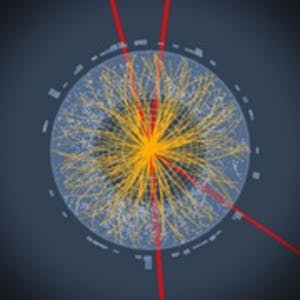Particle Physics an Introduction
This course introduces you to subatomic physics, i.e. the physics of nuclei and particles. More specifically, the following questions are addressed:
- What are the concepts of particle physics and how are they implemented?
- What are the properties of atomic nuclei and how can one use them?
- How does one accelerate and detect particles and measure their properties?
- What does one learn from particle reactions at high energies and particle decays?
- How do electromagnetic interactions work and how can one use them?
- How do strong interactions work and why are they difficult to understand?
- How do weak interactions work and why are they so special?
- What is the mass of objects at the subatomic level and how does the Higgs boson intervene?
- How does one search for new phenomena beyond the known ones?
- What can one learn from particle physics concerning astrophysics and the Universe as a whole?
The course is structured in eight modules. Following the first one which introduces our subject, the modules 2 (nuclear physics)
and 3 (accelerators and detectors) are rather self contained and can be studied separately. The modules 4 to 6 go into more depth about matter and forces as described by the standard model of particle physics. Module 7 deals with our ways to search for new phenomena. And the last module introduces you to two mysterious components of the Universe, namely Dark Matter and Dark Energy.
None
Syllabus
Syllabus - What you will learn from this course
Week 1
Matter and forces, measuring and counting
Week 2
Nuclear physics
Week 3
Accelerators and detectors
Week 4
Electromagnetic interactions
Week 5
Hadrons and strong interaction
Week 6
Electro-weak interactions
Week 7
Discovering new phenomena
Week 8
Dark matter and dark energy
FAQ
When will I have access to the lectures and assignments?
Access to lectures and assignments depends on your type of enrollment. If you take a course in audit mode, you will be able to see most course materials for free. To access graded assignments and to earn a Certificate, you will need to purchase the Certificate experience, during or after your audit. If you don't see the audit option:
What will I get if I purchase the Certificate?
When you purchase a Certificate you get access to all course materials, including graded assignments. Upon completing the course, your electronic Certificate will be added to your Accomplishments page - from there, you can print your Certificate or add it to your LinkedIn profile. If you only want to read and view the course content, you can audit the course for free.
Is financial aid available?
Yes. In select learning programs, you can apply for financial aid or a scholarship if you can’t afford the enrollment fee. If fin aid or scholarship is available for your learning program selection, you’ll find a link to apply on the description page.
Reviews
Is an absolute great course if you love physics and want to know more about relativity, some quantum basic and advanced stuff, also the teachers are very nice.
Challenging at first for someone with a non-traditional academic background, but thoroughly enjoyable and worth completing, if nothing but for the personal satisfaction of getting through it!
Way hard if you are not a science major! But the challenge is interesting. A quick advice : Refer to the slides if you find the accents too hard to understand.
Thank you for the great course!
Fantastic course for graduate students needing a refresher, or other folks with cursory knowledge of the topic already. Not a great course for someone's first introduction to the material.
